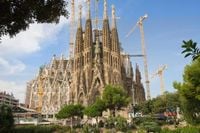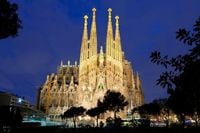After more than 140 years of construction, Barcelona’s iconic Sagrada Familia basilica is on the cusp of a historic milestone: the completion of its central tower, which will soon make it the tallest Christian church in Europe. The remarkable structure, a testament to both architectural ambition and spiritual devotion, is set to reach its maximum height by the end of 2025 or early 2026, according to the basilica’s General Director, Xavier Martínez. “This is an important moment in the history of the building of the Sagrada Familia because it will reach its maximum height,” Martínez told The Associated Press. “We are used to seeing skyscrapers like those in the United States (go up), but it is remarkable that in the 21st century we are building a cathedral.”
Once the Tower of Jesus Christ is finished, the basilica will stand at an astonishing 172 meters (about 564 feet), overtaking Germany’s Ulmer Münster, which, at 162 meters (531.5 feet), currently holds the title of Europe’s tallest church. The new tower will be crowned with a massive cross, designed to be the highest point in the city, yet intentionally just below the height of Barcelona’s Montjuic hill, which rises to 177 meters. This subtle nod to the natural landscape was part of Antoni Gaudí’s original vision, demonstrating the architect’s deep respect for both the divine and the environment.
The Sagrada Familia’s journey to this point has been anything but smooth. The first stone was laid in 1882, with Spanish architect Francisco de Paula del Villar at the helm. Just a year later, Antoni Gaudí took over the project, infusing it with his unique blend of organic forms, intricate symbolism, and vibrant stained glass. Gaudí, a devout Catholic, saw the basilica as a living testament to faith, weaving Christian iconography throughout every facet of the design.
Gaudí never expected to see the church completed in his lifetime—and indeed, he didn’t. When he died in 1926, struck by a streetcar, only one of the planned towers had been finished. His passing left a void, but his vision endured. Over the decades, the basilica has weathered wars, funding crises, and, most recently, the COVID-19 pandemic, which delayed hopes of completing the entire structure by the centenary of Gaudí’s death in 2026. Chief architect Jordi Fauli noted, “We have spoken of in about 10 years, but it is only an estimate.”
Despite these hurdles, construction has pressed on, funded almost entirely by admission receipts. Last year, a staggering 4.9 million people visited the Sagrada Familia, with 15% of those tourists coming from the United States. The basilica’s status as a global pilgrimage site and architectural marvel has only grown, with entrance fees providing the lifeblood for ongoing work. The completion of the central tower is just one chapter; work on the facades and interior will continue for years, with an ambitious goal to finish the full construction within a decade from now.
The central Tower of Jesus Christ is not rising alone. When finished, it will be surrounded by five other towers: one dedicated to Mary, and four slightly shorter ones for the four evangelists. In total, the basilica will eventually boast 18 towers and three elaborate facades, each telling a different part of the Christian story. The crowning cross atop the Jesus Christ Tower will serve as a beacon, visible across Barcelona and symbolizing the city’s enduring spiritual and cultural heritage.
The basilica’s significance extends far beyond its architecture. In 2010, Pope Benedict XVI consecrated the Sagrada Familia and designated it a minor basilica, even though it remained unfinished. This recognition cemented its role as a place of worship and pilgrimage. Next year, the centenary of Gaudí’s death will be marked by a series of events in Barcelona and across Spain, celebrating the architect’s legacy. The construction board has invited Pope Leo XIV to preside over a solemn Mass in Gaudí’s honor on June 10, the anniversary of his passing. Esteve Camps, the head of the construction board, shared, “We hope to receive a response this month.”
Yet not all recent developments have been without controversy. A plan to build a grand staircase for the basilica’s future main entrance has sparked protests, as it would require the demolition of several housing blocks in a city already grappling with affordable housing shortages. Negotiations with city authorities are ongoing, and the issue remains unresolved. For many locals, the basilica is both a source of pride and a reminder of the city’s evolving urban landscape.
Still, the Sagrada Familia’s allure is undeniable. According to the AP, the basilica has become one of Barcelona’s main tourist attractions, drawing millions each year. The steady stream of visitors not only funds construction but also supports the city’s economy, with hotels, restaurants, and shops bustling with pilgrims and architecture enthusiasts from around the globe.
The story of the Sagrada Familia is one of persistence, vision, and faith. From its humble beginnings in the late 19th century, through wars and pandemics, to its current status as a global icon, the basilica has inspired generations. Gaudí’s approach—melding faith with form, nature with structure—continues to captivate architects, artists, and believers alike. As the central tower rises, so too does anticipation for the next chapter in this extraordinary saga.
And while the finish line may still be a decade away, the imminent completion of the Tower of Jesus Christ marks a defining moment. It’s a reminder that some dreams, no matter how audacious or long in the making, can eventually touch the sky.





